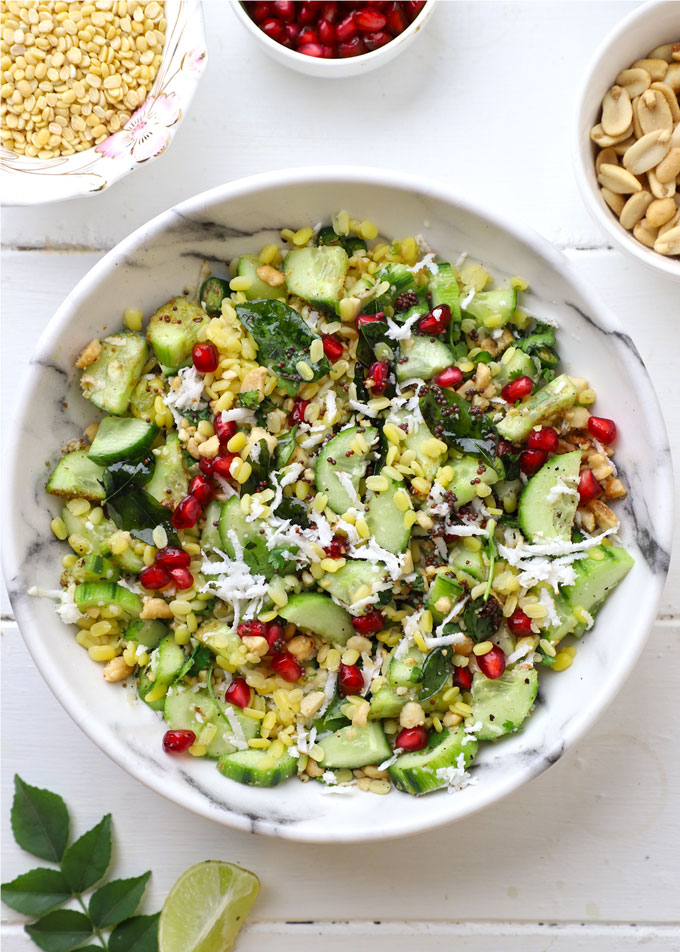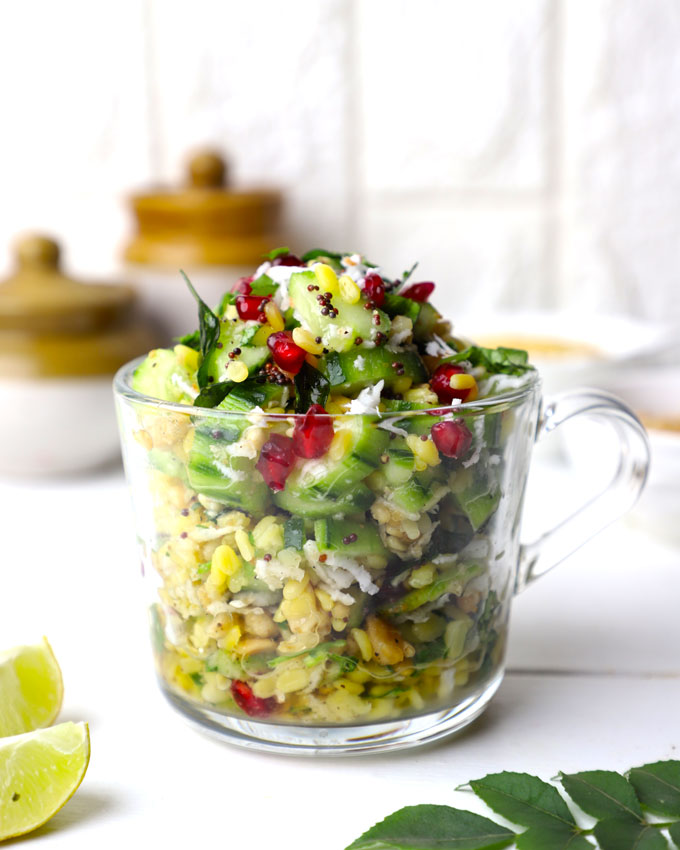Kosambari is a refreshing and nutritious salad that’s integral to the cuisine of Karnataka, a state in southern India. It’s known for its simplicity, vibrant colors, and the balance of flavors it brings to a traditional meal. As a staple in festive and religious occasions, kosambari is often served as part of the offerings during celebrations such as Ugadi, the Kannada New Year.
Typically, kosambari is made from soaked split lentils like moong dal or chana dal, which are high in protein and add a delightful crunch to the dish. The lentils are then mixed with finely chopped fresh vegetables such as cucumbers and carrots, which contribute a refreshing crispness and are rich in vitamins and fiber.
Kosambari Recipe


Kosambari
Equipment
- 1 medium bowl
- 1 large bowl
Ingredients
- 1/4 cup split yellow mung beans rinsed twice with cool water, drained
- 1/4 cup Bengal gram rinsed twice with cool water, drained
- 2 cups water
- 1/4 cup shredded carrot
- 1/4 cup shredded cucumber
- 1/4 cup shredded raw mango optional
- 1 teaspoon corn oil
- 2 teaspoons mustard seeds
- 1/2 teaspoon asafoetida
- 1 green chile finely chopped
- 2 tablespoons finely chopped fresh cilantro
- 1 teaspoon salt
- 2 teaspoons freshly squeezed lemon juice or lime juice
Instructions
- In a medium bowl, combine the mung beans, Bengal gram, and water. Let soak for 1 hour. Drain well and transfer to a large bowl.
- Add the carrot, cucumber, and mango (if using) to the bowl and toss to combine with the mung beans and Bengal gram.
- In a medium skillet over medium heat, heat the oil.
- Reduce the heat to medium-low and add the mustard seeds, asafoetida, and green chile. Cook until the mustard seeds begin to sputter, about 1 minute. Turn off the heat. Add this spice mixture to the salad. Stir to combine.
- Just before serving, add the salt and lemon juice. Stir to combine and serve at room temperature.
Notes
Cooking Tips about Kosambari

- Soak the Lentils: Start by soaking moong dal or chana dal in water for a couple of hours. This softens them and makes them easier to digest while retaining a slight crunch.
- Choose Fresh Vegetables: For the best texture and flavor, use fresh vegetables such as crisp cucumbers and carrots. Make sure they’re finely chopped to match the size of the soaked lentils.
- Drain Lentils Well: After soaking, drain the lentils thoroughly to remove excess water. This prevents the Kosambari from becoming soggy.
- Balance the Flavors: Kosambari is all about the balance of flavors – the earthiness of lentils, the freshness of vegetables, the spicy kick from green chilies, the tang from lemon juice, and the sweetness of grated coconut.
- Season Wisely: Just before tempering, season the salad with salt, keeping in mind that lemon juice also adds to the overall tanginess.
- The Importance of Tempering: Prepare a tempering (tadka) with mustard seeds, green chilies, and asafoetida in oil. Pour this over the Kosambari to infuse it with aromatic flavors.
- Add Lemon Juice Before Serving: Squeeze fresh lemon juice over the Kosambari right before serving to ensure the salad retains its vibrant flavors.
- Garnish with Coconut and Coriander: Freshly grated coconut and chopped coriander leaves add a delicious finishing touch to the salad. Both contribute to the aesthetic and enhance the taste.
- Serve Fresh: Kosambari is best enjoyed fresh. If it sits for too long, the ingredients can lose their distinctive textures and the salad may become watery.
- Adjust Spice Level: Depending on your tolerance for heat, adjust the amount of green chilies. Remember that they contribute not just spice but also flavor.
Serving suggestions about Kosambari

- As a Starter: Serve Kosambari as an appetizer before the main course to prepare the palate with its refreshing taste.
- With a South Indian Meal: It pairs wonderfully with traditional South Indian meals such as dosa, idli, or rice dishes, adding a crunchy, protein-rich side that complements soft textures.
- During Festivals: Present Kosambari as part of a festive menu during celebrations like Ugadi or other auspicious occasions to honor its cultural significance.
- With a Simple Lemon Wedge: A simple lemon wedge on the side allows guests to adjust the tanginess to their preference.
- Garnish with Fresh Herbs: Enhance the presentation with a garnish of additional fresh coriander or curry leaves.
- Part of a Health-Conscious Spread: Include Kosambari in a buffet that focuses on healthful dishes, showcasing its vegan-friendly and gluten-free attributes.
- As a Salad Course: Consider serving it as a separate salad course within a multi-course meal to spotlight its unique flavors and textures.
Top 5 FAQs about Kosambari

- What are the primary ingredients in a traditional Kosambari salad? Traditional Kosambari is made with soaked split lentils like moong dal or chana dal, along with fresh vegetables such as cucumbers and carrots. It’s seasoned with a tempering of mustard seeds, green chilies, and asafoetida, and often garnished with lemon juice, grated coconut, and coriander leaves.
- Can Kosambari be made ahead of time for events or gatherings? Kosambari is best enjoyed fresh due to the crispness of its vegetable ingredients. However, you can prepare the individual components in advance and mix them just before serving to maintain texture. The lentils can be soaked and the vegetables chopped ahead of time, but add the tempering, lemon juice, and garnishes right before serving.
- Are there any variations of Kosambari I can try? Yes, there are numerous variations of Kosambari. For example, you can add grated beetroot for additional color, pomegranate seeds for a burst of sweetness, or replace cucumber with raw mango for a tart twist. Adjustments can also be made depending on dietary preferences, such as omitting asafoetida for a gluten-free version since some asafoetida powders contain wheat flour.
- How should Kosambari be served during a meal? Kosambari is versatile and can be served as a starter to refresh the palate before the main course or as a side dish with a traditional South Indian meal such as dosa, idli, or rice-based dishes. It’s also a popular dish during festive and religious occasions like Ugadi, when it’s part of the celebratory fare.
- Is Kosambari suitable for people with dietary restrictions? Kosambari is suitable for various dietary requirements. It’s inherently vegetarian and vegan-friendly. It’s also gluten-free as long as you ensure that the asafoetida used in the tempering does not contain any gluten. Additionally, it is high in protein and fiber, making it an excellent choice for health-conscious diners.
Kosambari is a delightful, traditional South Indian salad that embodies the essence of Karnataka’s culinary heritage. This vibrant dish is a blend of soaked lentils, fresh vegetables, and a simple yet flavorful tempering, which not only makes it a visually appealing addition to any meal but also ensures a punch of freshness and health benefits.

Leave a Reply